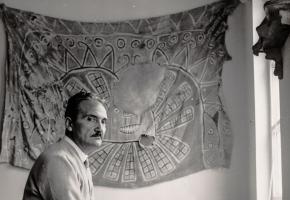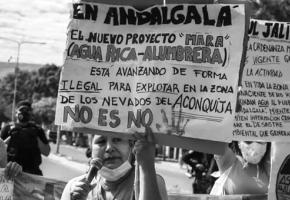Argentina
Cases of Covid-19 in Argentina are largely concentrated in its capital, Buenos Aires. Elsewhere, rates of infection are low enough to allow for the reopening of bars and shops. Businesses that open are to keep registers of customers and to restrict entry and opening hours to help track the virus in the case that a customer later tests positive. The contrast, for more distant provinces such as Jujuy is considerable.
Yet churches remain largely shut and limited to a maximum of 10 people in a service. One pastor in the Santa Fe region has devised a creative protest to the restrictions. Describing the restrictions as discriminiation, Daniel Cattaneo converted his church into a bar. Bar tables have been set up inside the church and the pastors dress as waiters, carrying bibles on trays. Cattaneo also planned a ‘drive-in worship’ at an open plot behind the church’s cemetery for his congregation to listen to this Sunday’s service.
Brazil
In Brazil, infection and death rates have reached record levels. Walter Braga Netto, the Chief of Staff of the Presidency, says the virus is under control and highlighted that Brazil has a lower death rate per million people than the worst-affected countries of Europe. So even though Sao Paulo saw its record number of deaths, the city is amongst others in Brazil that are starting to reopen shopping centres and other businesses.
However, activists from the NGO Río de Paz dug mock graves on the beach opposite Rio de Janeiro’s Copacabana hotel. Around one hundred holes were excavated during the night and headed with wooden crosses. Some crosses were cloaked in the Brazilian flag. The event pays tribute to the 40,000 people who, until then, had died in Brazil from the virus. But it was also a protest against the handling of the pandemic in the country. The organizer, Antonio Carlos Costa, criticised President Jair Bolsonaro’s failure to show solidarity with those who have suffered from the pandemic and to realise that it is one of the most dramatic crises in Brazil’s history.
 Mock graves dug by Rio de Paz activists. Photo: Daniel Silveira / G1.
Mock graves dug by Rio de Paz activists. Photo: Daniel Silveira / G1.
President Bolsonaro also came under fire when the ‘revamping’ of the health ministry’s webpage resulted in the removal of historic and current data about the pandemic, including the death toll and the number of infections. It was claimed that the move would ‘refine’ official coronavirus data. However, critics have compared it to the suppression of information in authoritarian regimes and the cover up of a meningitis outbreak in the 1970s by the then military government in Brazil. Two days after the change, supreme court judge Alexandre de Moraes issued a 48-hour deadline to resume publication of the figures. The president defended the move, tweeting that the data ‘does not reflect the moment the country is in,’ and that ‘Other actions are under way to improve the reporting of cases and confirmation of diagnoses.’
A study released in the same week as the George Floyd killing in the US, which has sparked antiracism protests across the world, shows the disproportionate impact of coronavirus amongst black and mixed-race Brazilians than whites. It has raised criticism of Brazil’s staggering racial inequalities in terms of living conditions, income, jobs, and access to health care. In the first quarter of 2020, black and mixed-race Brazilians earned less than 60 per cent of the salaries of white Brazilians, even though together they constitute 56 per cent of the population. Eighty per cent of black Brazilians do not have private health care plans and rely on the overwhelmed public health system. While many whites can self-isolate in apartments and work from home, many Brazilians of colour provide the vital services that put them at greater risk of infection and have to continue working or face starvation.
The study of 30,000 patients diagnosed with Covid-19 found that 55 per cent of black and mixed-race patients died, while the figure for white patients was only 38 per cent. An illiterate black patient was four times more likely to die than a white university graduate, according to the study. Yet the official data also does not cover all the cases and deaths in poorer sectors. Favelas in Rio de Janeiro have begun their own online counts to keep track.
See our latest on the impact of the virus amongst Brazil’s indigenous communities here.
Chile
In the midst of the pandemic and an increasing rate of infection, Chile’s health minister, Jaime Mañalich, resigned. The minister has faced growing criticism for his handling of the pandemic, including ‘dynamic quarantines’, Covid-passes, and especially the collection and reporting of data.
In April, Mañalich controversially announced that those who had died from coronavirus were included in the figure of recoveries, following a spurious logic that classified them as no longer contagious.
At the end of May, there were accusations that Chile’s coronavirus death figures were misleadingly low. However, Chile’s representative on the World Health Organisation (WHO), Fernando Leanes, reaffirmed that Chile’s figures were in line with WHO guidelines. He explained that any relative differences between the number of cases and the number of deaths in Chile compared to other countries was due to Chile’s high testing rates.
President Sebastian Piñera thanked Mañalich for his ‘commitment and total dedication’. A few days later, a government advisory group also reported that there are around 31,000 unrecorded cases in Chile due to different databases. Rafael Araos, a member of the group, said that there was ‘a significant number of people that have not been notified, or whose status has not been processed and continues to be pending.’
Mañalich’s resignation came after a new wave of criticism for the repeated changes in methodology used to report cases and Covid-related deaths deaths. The investigation website Ciper reported that the number of deaths reported to the WHO was higher than the number cited in the daily reports to Chileans. The day the report was released, the health ministry had reported to its citizens that the total number of Covid-related deaths was 3,101. To the WHO, however, it had reported over 5,000.
Dr Oscar Enrique Paris has taken over the role. Meanwhile, the ‘state of catastrophe’ declared in Chile due to the pandemic has been extended for a further 90 days. Chile has become one of the worst affected countries in the region. It has the third highest number of cases in Latin America, and the highest number of cases per million people in the Americas. The majority of its cases are concentrated in the capital.
Chile has become the latest country to surpass the number of cases in Italy – an early hotspot of the pandemic. The number of dead nearly doubled on Saturday June 20, according to the BBC, after the government changed the way it tallies the figure to include probable fatalities from Covid-19.
Quarantine measures have been extended in reaction to a continued increase in the number of cases. Fewer permits to go outside will be given out. The military has been dispatched to police the quarantine in Santiago after data about people’s movements showed that many Chileans continued to regularly leave their houses. Viceminister of the Interior, Katherine Martorell, said that the security forces are carrying out around 40,000 inspections a day. Fines of up to US$63,000 are issued to those who have tested positive for coronavirus who break self-isolation.
However, the use of the military appears to be as much about quashing protests as about enforcing quarantine. The data showed that it was more common to go out in poorer neighbourhoods. Captain Nicolás Zamora, openly commented that that poverty and hunger adds to the tensions that linger from the protests that swept the country in October. The residents of some of Santiago’s poorer neighbourhoods had taken to the streets at the end of May to protest their inability to work and lack of government support. They complained they were having to choose between dying of coronavirus or of hunger.
Meanwhile, miners have raised concerns that they are not being protected. Chile is the world’s largest producer of copper and second largest producer of lithium. Neither industry has reduced production during the outbreak. Trade unions have complained that sanitary measures are not being enforced. Although a regulator has denied this, the unions question the continued operation of the mines and have asked for a place at the table in the discussion of preventative measures.
The referendum to decide a new constitution could be further postponed due to virus. Before his resignation, Mañalich had suggested that the situation remained too uncertain to allow planning for the referendum. It was initially due to be held on 26 April, but it has been delayed until the 26 October. However, the country expects to restart the football season at the end of July.
Colombia
As Colombia’s president Duque faces criticism for a lack of leadership and an ineffective lockdown, regional leaders have enforced their own rules to tackle coronavirus. Although Bogotá, Calí, and Cartagena still face overwhelming numbers of cases, Medellín mayor Daniel Quintero’s approach has proved a success.
Of the 2.5 million residents of the city, there have been only four confirmed coronavirus deaths. Only ten coronavirus patients are in ICUs, and the city had only 741 confirmed cases as of 13 June.
Medellín had some pre-existing advantages that have helped to limit the impact of coronavirus; its international airport receives fewer foreign travellers than Bogotá, for example, and its public health system is much better than most elsewhere in Latin America. However, many accredit the low numbers to early preparation. Some accused Quintero of being excessively cautious at a time – back in January – when coronavirus seemed a geographically very distant threat. However, his proactive planning included the creation of an app that connects those in need with food and monetary aid, and that tracks cases and monitors patients.
 A police officer uses software to scan the identification card of a Medellín resident to check if she has authorisation to be out in public. Photo: AP / Luis Benavides.
A police officer uses software to scan the identification card of a Medellín resident to check if she has authorisation to be out in public. Photo: AP / Luis Benavides.
There are legitimate worries about how the data collected by the app could be used for matter unrelated to Coronavirus, especially for human and environmental rights activists who are regular targets of attacks and killings in Colombia. However, Quintero responded that ‘the question of our intentions in how we use this data can’t be doubted.’
See LAB’s latest on Duque’s leadership under Covid here.
In the city of Cúcuta on the Colombia-Venezuela border, Venezuelan migrants have gathered waiting to return home. As we have previously reported, many migrants have found themselves without work, as the informal sector has disappeared. An estimated 74,000 Venezuelans have voluntarily returned to their country from or through Colombia, to access healthcare and accommodation and to be with their families.
The Venezuelan government, however, has limited the number of those who can return to 1,200 a week, leading to the gathering of migrants on the border. Colombian authorities have set up a health centre to provide health care, accommodation and food. The Secretary of Borders and International Cooperation of North Santander explained that the centre is ‘not a hostel nor a refuge [but] it is a transit station in which migrants will wait for a maximum of 48 hours at a time to enter their country.”
Honduras
Honduran president, Juan Orlando Hernández, was taken to hospital on Wednesday after testing positive for Covid-19. He is being treated for pneumonia at a military hospital. A spokesman for Honduran health agency SINAGER reported that his general state of health was good. Two of his co-workers as well as his wife have also tested positive; the latter is asymptomatic.
Mexico
In our 5 June update, we reported that Mexico was reopening some factories despite increasing numbers of confirmed cases. Since then, the number of deaths has increased, and allied and opposition parties alike have broken with President López Obrador’s policy. The strategy was to follow the Modelo Centinela [lookout model], which was created in 2006 to track seasonal flu through a network of monitoring stations. However, the model has been criticised as unsuitable for the virus and unable to provide a general outlook of the situation in Mexico.
States controlled by the opposition have started to increase testing as the date for the expected ‘peak’ has been pushed back. Three thousand cases that were not reported by federal figures have been confirmed in Nuevo León and Coahuila.
Despite Mexico’s high position in the global infection tables, some tourists are making the most of Cancún’s empty beaches and the low costs. Officially, the beaches are shut to the public; the state governor hopes to open them but not for a few weeks more. However, the need to reopen the economy has allowed for hotels and some restaurants to open under strict hygiene practices. The local airport is receiving flights from the US. Hotels have been instructed to let their guests go to the beach as individuals, rather than in groups.
Nicaragua
Nicaragua’s leadership has continuously denied community transmission of Covid-19 in the country and has made efforts to suppress figures showing its real impact. However, there are rumours that the leadership themselves are contracting the virus. Twenty prominent members of the ruling Sandinista party are known to have died after showing symptoms typical of Covid-19.
One of them was Edén Pastora, known as ‘Comandante Cero’, who died aged 83 on Tuesday. His family reported that he has suffered from respiratory issues for the previous ten days. He had been a key figure in the Sandinista
Revolution in 1978 and is known for his role in the seizure of the National Palace and kidnapping of the politicians inside. After a brief time fighting for Contras (against the Sandinistas) in the 1980s, he returned to the Sandinista fold in 2006 and took up a place in government.
Nicaragua’s health ministry publicly states that the number of confirmed cases is 2,014, and the number of deaths, 64. However, other independent estimates elevate the figures to 4,000 and 980 respectively.
Peru
A lack of bottled oxygen has led Peru to import oxygen from its neighbours. According to Peru’s Ministry of Defence, the country requires 173 tonnes of oxygen a day to meet the current demand. The Peruvian College of Medicine has reported that the country only produces around a fifth of that amount.
Patients’ families have reported that they have to secure their own sources of the gas, often at wildly elevated prices. On the legal market, oxygen is at S/.50 (US$14) per cubic metre – twice the pre-coronavirus cost. On the black market, it can cost as much as S/.650 (US$185) per cubic metre, or US$1,850 for a standard 10 cu.m. cylinder (a Covid patient can need up to 10 cylinders per week)./
Venezuela
Restrictions are being lifted in Venezuela after three months of strict lockdown. On Wednesday 17 June, it registered its record of 236 cases. NGOs and John Hopkins University, which is producing statistics on the pandemic, have expressed their doubt over the official figures. Even if the true figures are substantially higher – as is likely for Brazil especially, the UK (to judge by the surge in expected deaths) and many other countries around the world – it is hard to avoid the conclusion that Venezuela, so far, has fared better than many of its neighbours. This is surprising given the precarious economic situation, desperate state of the health service, the amount of cross-border movement with Colombia and Brazil and, prior to the pandemic, the frequent travel to Europe and the US by middle-class Venezuelans.
Nonetheless, a schedule alternating five days of eased lockdown with ten days of quarantine started on 1 June. This was changed after a week to seven days easing, seven days lockdown, although only in certain sectors.
While the world’s economy is drastically suffering as a result of lockdown, the impact of sanctions against Venezuela and its isolation in the international community has made a desperate situation dire. The country lacks medical supplies and equipment, as well as basic sanitary items and running water in many places. An agreement between President Maduro and opposition leader Guaidó has offered hope that the situation may change.
Country by country summary. Case and death figures from WHO Situation Report 153, 21 June 2020, and John Hopkins University Coronavirus Centre as of midday, 21 June 2020.
Reports from some individual governments and unofficial sources suggest considerably higher figures.

Emily Gregg is a LAB correspondent and author. She lived in Arica, Chile, until returning to the UK because of the pandemic, and wrote The Student Revolution chapter in LAB’s book Voices of Latin America (2019).
This article was first published by the Latin American Bureau, for more great articles visit www.lab.org.uk

















